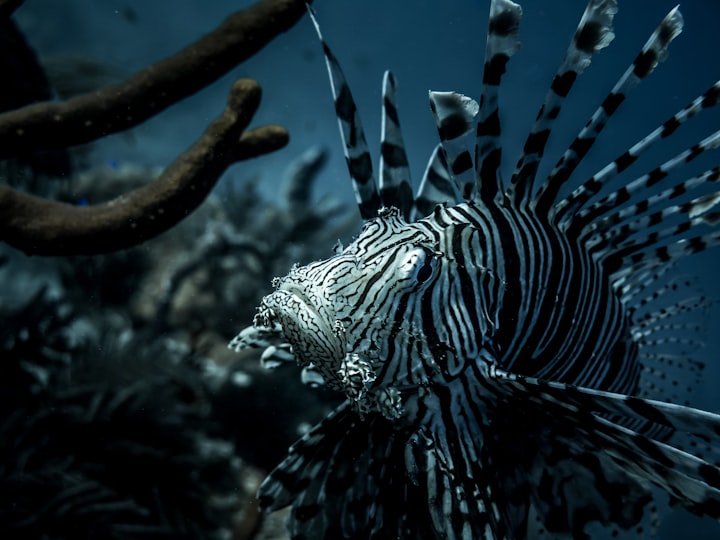
From the deep-seated sea monster that drives up to 50 miles [80 km] an hour with a sharpened nose, we look at the Most Dangerous Marine Hunters. Here presented is the list of the top 10 Marine Species.
Number 10. Ocean LionsSea
Lions are a group of underwater winged landmarks in the underground and in the tropics. Within their various species, sea lions can grow in size from 220 pounds [220 kg] to 2,500 pounds [2,200 kg], with a variety of species ranging from tox to ten feet. Known for their amazing knowledge, the sea lions had the option to learn the habits of the prison. This does not mean, however, that they are all friends. The onslaught of sea lions has taken place in California, and elsewhere, as the warm-blooded sea animal often exhibits a grudge against the region. This shows in their rebirth season, as many sea lions tend to harass and squirm in the warmth of the competition.
Number 9. Lionfish
As bad as the damage may be, Lionfish are notorious for being the most dangerous fish in the ocean. With the beautiful introduction of a cautious color, similar to that of a deep red coral snake, smooth whites, and black groups, this fish stands out in the middle of the ocean. The toxins soldered give it an almost bold appearance as a large amount of soap comes together to form a simple layer around the fish. Besides being almost large enough to eat humans, Lionfish are known to be extremely dangerous to anglers and jumpers in terms of their pain, illness, and loss of toxic movement.
Number 8. Barracuda
Although it has evolved over 20 different species, one thing remains the same: a barracuda attack at a slower pace like a slave at sea. In addition to being fast and limited, barracudas range in size from two to three inches [2-3 cm]. The aggressive hunters persisted in their attack, setting a good point before jumping forward at speeds of up to 27 miles per hour to hit their prey. A characteristic hurricane, barracuda is known to confuse people and hunters and can follow them to eat once they are not stuck on a pole or two. And they are also known for attracting glitter and glitter, confusing them with the size of a deer. Truly terrifying predators, barracudas are kept away from them. Contact, hand care, or even spearfishing near barracudas is especially recommended, as the brutal method in which it attacks preys is not worth the risk. In any case, in all its basic negligence, even barracuda becomes a victim sooner or later. Commonly eaten as filets or steaks, barracuda serves as a popular food and sport fish worldwide.
Number 7. Panther
Symbols called big, earthy, and cruel cats, the Panther Seal is one of the most dangerous signs in the world. Known as meander antarctic, panther seal ranks follow behind the orca as the dominant hunter in the region. The sports panther seal is evenly spaced on its body. This allows it to digest and feed on a wide variety of prey, from fish and squid to penguin combinations to very different markers. Panther signs can range in size from 440 pounds to 1,320 pounds, with a range ranging from 7 to 11 meters. This large warm-blooded animal, though with an amazing jaw and inclination like its great counterpart, also produces mysterious thunderstorms, which merely intensify the hunter's astonishing posture. Although the attack was clearly public, in 2003 the panther seal required 28-year-old Kirsty Brown, a diplomat swimming in an Antarctic island, immersed, a time she could not tolerate.
Number 6. RaysDistant
Members of the shark family, cartilaginous animals [kar-tih-la-jih-nes] animals known as rays are often familiar with their bat-like wings and bodies of similar size. Most notable, though possible, are their natural defenses that will only be dangerous as they are different. Perhaps the most dangerous beams are the stingray. In groups of species in eight families, stingrays come in all shapes and sizes. The stingray, wherever it is, or any of its various species is usually defined by toxic muscles, covered with skin from its tail. This toxin requires little energy to produce and store within the tissue cells and is known to cause serious and deadly damage when it afflicts humans. However, in addition to their immeasurably dangerous forces, humans often connect and swim with stingrays at marine and ocean fairs. Another dangerous beam is the electric beam. More circles than a stinging family member, the electric beam is known for its proximity to harden and cripple inexperienced and potentially dangerous opponents. With a power output of up to 220 volts, the beams often rely on this deer-crossing device in addition to self-defense. From the earliest times, an electric pole, or torpedo fish, could have become the backbone of an earlier medicine in which doctors and doctors would place this so-called mysterious animal to correct brain pain and gout.
Number 5. Humboldt
Squid Named Diablo Rojo, or Red Villain, by Focal American anglers, Humboldt squids are known to be very powerful. With an average size of 5 feet [5 m] and a power of up to eight feet [8 m] or more, this powerful type of jacket can push itself against predators such as the red-water vessel at speeds of up to 15 miles per hour. In the storm of red and white, Humboldt squid streaks and bioluminescence during its chase, get its name, Diablo Rojo. Humble additives come from squid and surround its sharp nose, each with columns with many chicken teeth. When cared for, the Humboldt Squid was seen free of charge to all with nothing but highlighting where the use of human flesh is unavoidable. Further findings recommend this type of squid really which may indicate a great hostility when cared for, and outside of this area, the display looks as curious and intelligent as an octopus. So in case, you choose to swim with the Red Devil, be sure to take care first!
Number 4. Atlantic Blue Marlin
Although not often used in the media as a quintessential prize fish, Atlantic BlueMarlin is one of the best-known marine trackers. Arriving at more than 6,000 pounds [1,900 kg] and weighing up to 14 feet [14 m], it is not surprising that this fish takes up both parts of a large predator. This blue fish pursues a variety of life forms, using its large needle-like nose to shock and reverse fish schools ranging from small mackerel to 100 pounds of fish. In addition to the impressive size and natural piercing device, the blue marlin features another particularly effective weapon: a lovely speed. The marlin can reach a distance of about 80 miles [80 km] as it speeds through the waters of the Bahamas, making it one of the fastest fish in the ocean. However, the high-fat, heavyweight, and incredible chamber make Atlantic blue marlin perhaps the world's most popular fish. Like many others in this rundown, this marine pilot is considered to be an endangered species.
Number 3. Clay Bears
Despite being the world's most vertebrate, the Polar Bear is probably the most endangered species in the middle of the Icy Sea. Sitting across the Icy Circle, these delicate bear species conserve a large portion of their energy on the sea ice by chasing symbols. This gave the hunter the nickname "the sea bear," as it depends on the strength of the sea ice to endure. With loads of up to 6,000 pounds [1,500 kg] or more and nearly 8 feet (8 feet), adult bears are large animals ready for destruction. This size fills a double demand as its extra fat saves filling as a food container for quite some time when sea ice is not available. Because of their amazing sense of smell, polar bears are known to have the option of identifying almost one seabird farther than three feet [3 m] of snow. Fortunately for humans, this great awareness has never been used by humans. Generally, polar bears tend to attack humans unless they are stimulated or starved. Most of the attacks on the highland bears, however, have been reported to be fatal because they are not at all similar to their earth-colored brothers, the highland bears who are fans of hiding. During the chase, it is very difficult for the victim to see the polar bears coming from their local climate. Indeed, even infrared cameras do not neglect to detect polar bear heat due to their thick, long fur coats. Even though the existing beast has worked to withstand extreme weather conditions, the polar bear is another animal in this currently endangered rundown, in this case, due to environmental changes. As sea ice becomes more unusual and more complex, the ability of polar bears to adapt to their vital food supply becomes a major challenge. This means that any closeness of people is likely to look like a strong bond at this point ...
Number 2. Incredible White Shark
With its famous heartless, black view and endless columns of rough teeth, the amazing white shark is perhaps the most feared animal in the ocean. Growing up to 50 feet [15 m] in height, the rare white shark is the world's largest hunter among fish. Their torpedo-shaped, black and white corpses are intended for immediate attention or even above water chambers. Unusual white chase as a blood machine designed to detect abnormal odors, linearized teeth, and electric field organs make it ideal to follow the victim. Living mainly on small dental implants, part of this shark has even been known to eat sea turtles and meat! While intended to be as intimidating as entertainment, Jawsis is not far off about the amazing white shark. In at least 100 shark attacks worldwide per year, 33% to one-half can be considered stunning white. However, repeated attacks have otherwise reported what researchers call a "bite test," in which a common white curiosity causes the shark to attack the injured after being caught.
Number 1. OrcaAs
The largest family of the orca dolphin, or the executioner whale, is one of the world's largest marine hunters. With up to 4 teeth moving in length, these cold-water tracks devour animals as much as symbols, sea lions, and in some cases even whales. To soak cold water in up to 40 circles, these chase tracts or cases as they are known to use clever chasing techniques to reduce their prey. Like sea wolves, orcas attract energy by chasing deer. In addition, with a standard area load of up to six tons ... that is part of the loot to chase each unit Unless fictional and media paintings give the orca a certain status, these warm-blooded sea creatures are predators and eat the head of a whale.





Comments
There are no comments for this story
Be the first to respond and start the conversation.